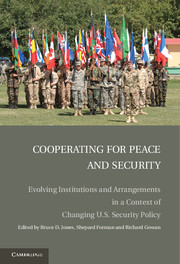 Cooperating for Peace and Security
Cooperating for Peace and Security Book contents
- Frontmatter
- Contents
- Contributors
- Foreword
- Acknowledgments
- I FRAMEWORK
- II ADAPTING COLD WAR INSTITUTIONS
- 4 An Evolving UN Security Council
- 5 Too Many Institutions? European Security Cooperation after the Cold War
- 6 Whither NATO
- 7 The Evolution of Nuclear Nonproliferation Institutions
- 8 9/11, the War on Terror, and the Evolution of Multilateral Institutions
- 9 Evolution and Innovation: Biological and Chemical Weapons
- III NEW TOOLS, NEW MECHANISMS
- IV CONCLUSIONS
- Index
- References
7 - The Evolution of Nuclear Nonproliferation Institutions
Published online by Cambridge University Press: 22 January 2010
- Frontmatter
- Contents
- Contributors
- Foreword
- Acknowledgments
- I FRAMEWORK
- II ADAPTING COLD WAR INSTITUTIONS
- 4 An Evolving UN Security Council
- 5 Too Many Institutions? European Security Cooperation after the Cold War
- 6 Whither NATO
- 7 The Evolution of Nuclear Nonproliferation Institutions
- 8 9/11, the War on Terror, and the Evolution of Multilateral Institutions
- 9 Evolution and Innovation: Biological and Chemical Weapons
- III NEW TOOLS, NEW MECHANISMS
- IV CONCLUSIONS
- Index
- References
Summary
The end of the Cold War represented the first real opportunity to extricate the world from the nuclear dilemma. But what seemed possible in the early 1990s – that states might finally eliminate nuclear weapons from their military postures – seemed, by 2006, to be a distant hope at best, an opportunity lost.
This is not to downplay the importance of what did happen following the Cold War's demise. Between 1990 and 2006, the United States and Russia reduced their nuclear arsenals from nearly 58,000 warheads (more than 95% of the world's total) to 26,000, with promises to continue reductions. As these reductions occurred, the United States and Russia cooperated to secure dismantled nuclear materials in Russia, an action that would have been unimaginable a few years before. And more generally, nuclear rivalry among the major powers abated as the potential for all-out nuclear war receded.
But there is another side to the story. Existing nuclear powers had continued to upgrade their arsenals. It became clear that four additional states had acquired nuclear weapons, all in politically sensitive areas where there were few agreements to manage the threat of their potential use. The United States withdrew from the Anti-Ballistic Missile Treaty and moved to deploy missile defense systems. The risk of further proliferation, and the desire of nuclear weapon states to preserve the military advantage that these weapons confer, continued to drive much of international political relations.
- Type
- Chapter
- Information
- Cooperating for Peace and SecurityEvolving Institutions and Arrangements in a Context of Changing U.S. Security Policy, pp. 122 - 142Publisher: Cambridge University PressPrint publication year: 2009
